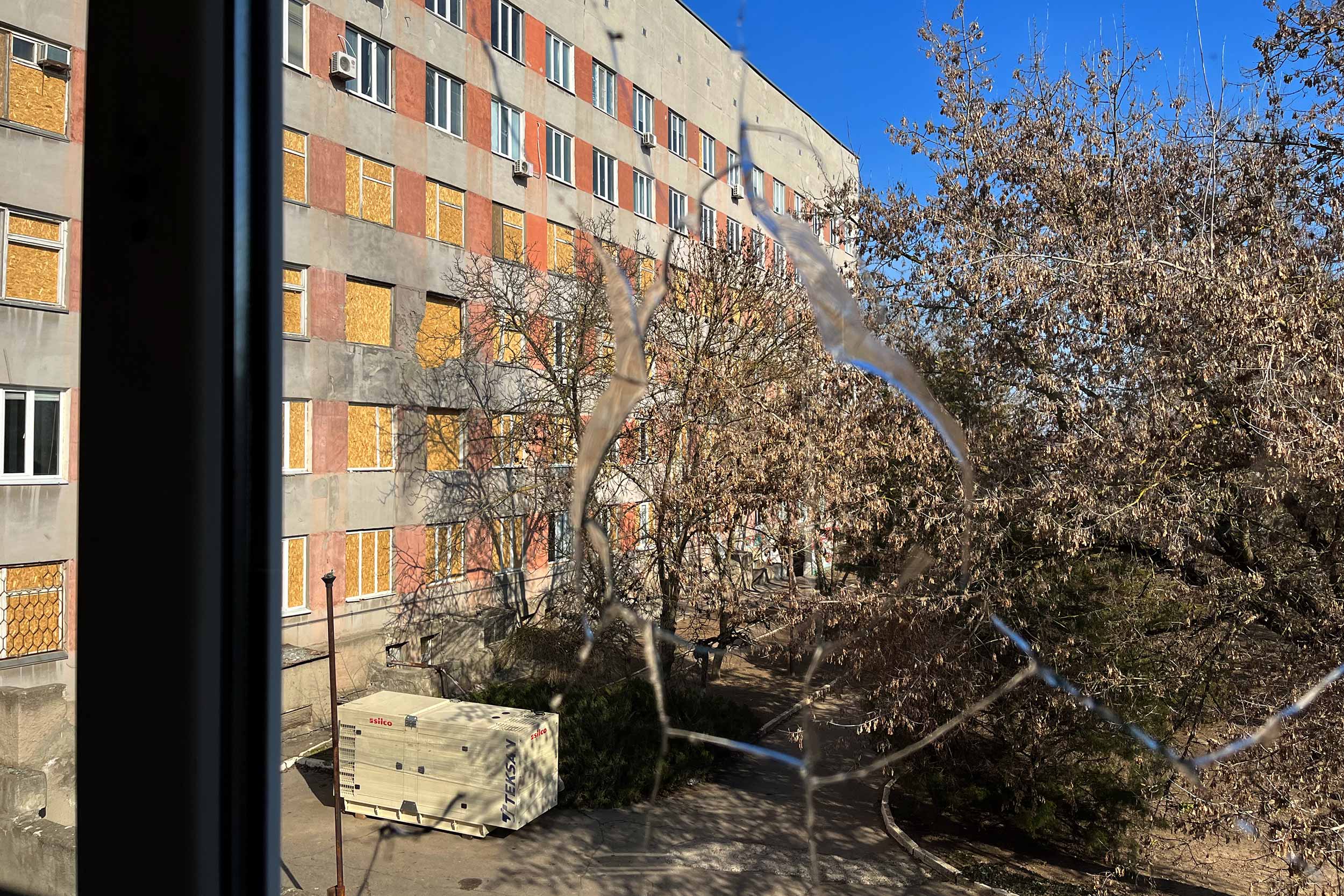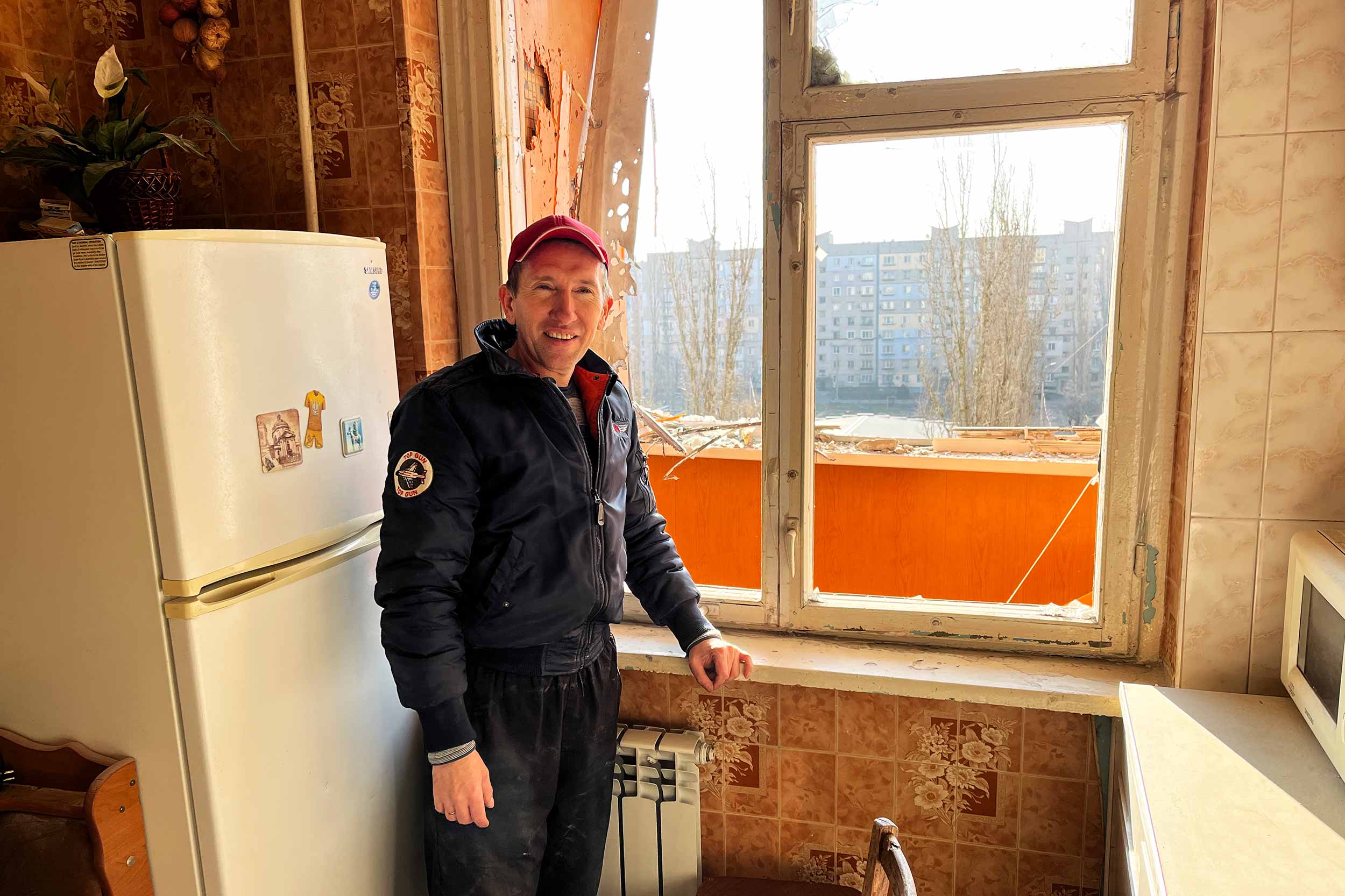“Shelling Just for Shelling”
Indiscriminate Russian attacks continue across the frozen frontline.
“I was almost asleep, around 10 or 11 o’clock, when I looked out the window and it was like a red dawn,” said Alla, 64, whose windows in the neighbouring building were blown out in the blast. Glass was strewn on the ground, and next door the shell left a gaping hole six floors up.
A second shell landed some way down in the middle of the common courtyard, spraying shrapnel, destroying a brick wall and blowing out windows. A third, the next courtyard over, smashed into the front of another apartment block. The attack caused destruction and distress, but apparently no injuries.
Such missile strikes have now become a routine part of life in the area.
“They are unable to aim for any locations of the Ukrainian armed forces, so every day they hit residential areas. There is no military purpose for these attacks. It is shelling just for the sake of shelling.”
Ostriv lies in the middle of the Dnipro River, making it the closest Ukrainian-held position to Russian forces on the opposite bank, up to one kilometre away. Many long-time residents worked in Kherson’s ship-building industry. Now it receives the largest share of incoming fire of any part of the hard-hit city.
“I’ve lived in this district since I was 16, and during the occupation,” said Yulia, 39, a lawyer. ‘Now it’s very hard, shelling is going on day and night. Almost every building here is damaged. The heating system is destroyed, so we live without central heating.”
According to official figures, there are some 35 and 100 shell attacks each day on the Kherson region, perhaps even more. A series of devasted villages stretching up river continue to be hit, but a significant if not majority number of shells unleashed hit Kherson city directly.
The showcase regional administration building in Freedom Square - in front of which citizens gathered in such joy after last November’s liberation – suffered a significant hit in mid-December, creating a gaping tear on its side. It now stands empty.
The administration assessed that 62 educational institutions have been shelled, including kindergartens, and 19 medical facilities, including two neo-natal wards. More than 700 windows have been knocked out of Kherson children’s hospital, a significant facility for the region, which continues to function but on a much-reduced basis.

So far, 44 infrastructural sites have been hit, including electrical, water and heating systems, and 1,434 residential buildings have been destroyed or damaged, according to official figures.
Dmytro Pletenchuk, public affairs officer for the Kherson regional military administration, said that in the months since liberation, 77 civilians had been killed in Russian mortar and artillery attacks in the city, and more than 200 injured.
“The Russians are trying to show that they are militarily present in the region while they are situated at the left bank of the Dnipro River,” Pletenchuk said. “We do not see any signs of them forming any special groups for an assault, and given that there is a natural barrier in the river, an attack seems unlikely.
“They are unable to aim for any locations of the Ukrainian armed forces, so every day they hit residential areas,” he continued. “There is no military purpose for these attacks. It is shelling just for the sake of shelling.”
Indeed, the overriding feature of the attacks is how random they are. With expensive cruise missiles reserved for more remote targets, the centre of Kherson is being struck with mortar, artillery and multiple-launch rocket systems from three or four kilometres away.
These munitions are not precision, and at that range it is estimated that targeting can be off by 100-200 metres, a massive distance in a residential location. Whether Russian forces target civilian areas – such as Ostriv – or infrastructural locations, shells are equally likely to land anywhere in a wide radius.
Estimates are that only 60,000 of the pre-war population of more than 330,000 remain. This means that number of deaths – however large – is reduced from what it could be.
Yet tragedies and traumas continue. Just last week, the regional administration lost a 24-year-old colleague, who was killed by a mortar on his home.
On December 31, a toddler boy and his sister were walking down the street, when a shell landed nearby, injuring both. A major bleed from the boy’s wounded leg endangered his life, and he was rushed to the children’s hospital to receive an emergency infusion – where a shell struck the room just next door, blowing out the windows. Hit by half-a-dozen shells that evening, the hospital could not continue to function, and the boy had to be rushed to Mykolaiv, where he remains awaiting a further operation.

The hospital is now taking patients, but at a reduced level, and another strike is expected.
“You can hear with your own ears what’s going on, they are shooting wherever they want,” said hospital doctor Stanislav Bumbu. “Recently there was a hit on a private house just a block away from us and a hit on another house in the other direction. So you are always waiting.”
While the war grinds forward around Bakhmut and other beleaguered towns in the east, in Kherson the situation has reached an enforced stability, as neither side can advance across the freezing and heavily guarded waters of the Dnipro.
“It’s a position war, an artillery war only, that’s it,” said Pletenchuck.
That’s the grim reality on Ostriv, where residents mix a hearty spirit with constant fear. The looming apartment blocks are tired eight and nine-storey Soviet-era structures, stretching around broad and bedraggled common yards, playground areas alternating with rubbish skips, dirt areas intended for grass, and bare tall trees.
Those who remain are a self-selected group – they may be old or without resources to go elsewhere, have someone to care for or are determined to stick it out.
“We are very anxious, we live on the frontline,” said 84-year-old resident Vladimir. “They are shooting at night, shooting at day, you can’t know where they are aiming. How can I count them when they are shooting all the time?”
In the flat that was hit on February 10, a couple is sweeping up the broken glass in their kitchen. The shell destroyed the small balcony and wrecked the window, but did not cause structural damage. Fortunately, they were not at home.

Until the war started, Vyacheslav, 47, worked at the nearby shipyards – a major Ukrainian facility – and he was determined to remain at home as long as possible. But by December, the shelling in their yard became routine, and they relocated to Mykolaiv at the behest of their daughter.
“We were staying here until the last moment when we realised we had to leave,” he said.
Yulia, the lawyer, explained that she allows her 14-year-old son to go out in the yard near their house, to play with up to ten other local kids. It’s a reversal from only a few months earlier when, under occupation, she refused to let her son out of the house in case he was pressed into mandatory Russian education.
“I really love my city, if everyone leaves there will be no Kherson,” she said. “As long as we remain here, the city will exist. We will defend it. Everyone will defend it. People have to stay.”
Translation and additional reporting by Mykhaylo Shtekel.
